Text
THE TIME HAS COME!








Now showing my RWS, yet not RWS, Realistic Toby not Toby the Tram Train!
I bought this model a couple months ago at the Warley Model Railway Exhibition (2022) with the intention of making Toby in pre-sodor/realistic condition. This is mainly down to an edit to an illustration I did but also due to a fondness for Eastern locomotives.
The model was an LNER Lined Black J70 produced by Rapido my first plan of action was to gather reference material for Toby, GER No.127, LNER No.7127 later No.8221 or BR No.68221. I searched EVERY number for Toby and I only have 6 images of him to use.
I'm basing Toby on the picture of 7127 in LNER plain black, which is the attached image.
7127 was rather simple, repaint its frames into Black, using Gloss on the main sections and Matt on the bufferbeams, and added the transfers, which are LNER Lettering and Bufferbeam Numbers from Fox Transfers, I then left these alone to allow them to set. I also decided to swap out the cow catchers for the "full" ones instead of the catchers to allow for the NEM Pockett. After modifications were made I heavily dosed it in Weathering powders. I went for a Harbour/industrial look for him due to 7127 working at Ipswitch Dock in the depiction of the Model.
He fits in nicely with my Eastern Fleet, I just need to have him run on a proper harbour layout.
19 notes
·
View notes
Text
OH HELLO!
Yes I know It's been a while but we just love it when LIFE gets in the way.
Anyways, today I'm bringing you NOT JUST ONE but TWO models that I have recently finished. The first being of my Kerr Stuart Joffre.
So a bit about the KS Joffres before we get into my model.
The Kerr Stuart Joffres were ordered by the French Government for use on the War Department Light Railway network. Kerr Stuart built 70 members of this class which looked identical to the French Company's Decauville 0-6-0 Well/Side Tanks.
They were built in three Batches;
Batch 1 (1915) Nos. 2402 – 2416
Batch 2 (1915) Nos. 2428 – 2457
Batch 3 (1916) Nos. 2995 – 3019
After the war most of these locomotives were sold across France and worked on the Various 2ft/600mm gauge railways alongside Baldwins, Alcos, Hunslets and so on.
After the War, Kerr Stuart, with a stock of the parts used on the Joffres, made an identical design called the Haigs, these were essentially the Joffres but with Stove Pipe Chimneys instead of Baloon Spark Arrestor Chimneys and the lack of a Well Tank between the frames.
After a majority of the French Narrow Gauge Railways closed down, a number of Joffres were purchased for A Museum Project at Pen-yr-Orsedd Quarry, before this project was moved to the Gloddfa Ganol Slate Quarry complex near Blaenau Ffestiniog in North Wales. They remained there for some years until the Museum closed down.
Most of the Joffres have been lost or scrapped, however 5 members have been preserved in the UK, all coming from Gloddfa Ganol.
2451 - 'Axe' - Preserved at the Lynton and Barnstaple Railway.
2405 - 'Joffre' - Preserved at the West Lancashire Railway.
3014 - Preserved by the Mosely Railway Trust at the Apedale Railway.
2442 - Privately owned in Kent.
3010 - Preserved at the Statfold Barn Railway.
Now onto my little fake history for my Joffre 3020:
Built in 1916 for use overseas in France, Kerr Stuart Works No.3020 was apart of the WDLR Stock commissioned by the French their artillery railways. The Joffre’s bore a similar design to the Decauville built 0-6-0s, so many parts, despite being built by different manufacturers, ended up being used on 3020. 3020 remained in France and found on many different railways.
The Locomotive was going to be called “Le Souvenir” or “Remembrance” but as it was sold to so many different railways, the locomotive never received its intended name. Instead the locomotive was nicknamed “Joffre” or “Joff” which stuck, leading the locomotive to be known as Joffre ever since. In 1945 at the end of the Second World War, Joffre found itself at the bottom of a quarry in the south of France, people claiming to be never seen working again. However, there was hope for the engine.
In 1974, nearly 30 years later, a preservation team went and rescued the engine, before it was moved via road to a dockyard in the north of France. There Joffre met some of its other siblings, and was loaded onto a ferry named “Free Enterprise VII” on the 11th October that same year. 3020 was repatriated to the UK alongside some of it’s siblings and was moved to a museum project at Pen-yr-Orsedd Quarry in North Wales.
Joffre was moved again to Gloddfa Ganol Slate Quarry Museum and was plinthed with a short rake of wagons to look like a quarry train. The locomotive was painted a bright yellow and was known as “The Happy Train by the Gift Shop!” Eventually Gloddfa Ganol closed and the locomotive was put up for sale in 1998. It languished in the quarry while it's siblings were purchased by Railways and private owners. Rust had left holes in the tank and its yellow paint had faded to an off white. It didn't look like the happy train anymore.
Luckily the locomotive was purchased by a private owner and was restored. People questioned why the owner decided to restore the locomotive to its Gloddfa Ganol look, with its bright yellow paint and red lining. The response always being "How often do you see a Yellow Engine in Preservation?"
Joffre goes about visiting railways frequently and has become "the Happy Train" once again.
My Model of the Joffre is one of the Chivers Five79 Joffre Kits, which depicts the locomotive in its Gloddfa Ganol condition. I chose this against 3D printed representations of the model on a number of factors. 1- I prefer this look for the Joffres, I don't know why, but I think it's because I prefer the Stove Pipe Chimneys. And 2- the kit is white metal, meaning I didn't have to add any weight into the body as the kit provided all the weight.
The chassis is from one of the Narrow Gauge 0-6-0s that the company produces. This loco was sent to me by accident when I ordered another loco for a different project. However I realised what I could do with this loco (making the Joffre), so I emailed the shop, told them their mistake and the money difference was sorted.
When the body kit arrived, I had a slight issue. While the motor and chassis are identical, the Kit was designed for the Roco N gauge BR80, not their 009 0-6-0. The worm gear, I think, is mounted lower on the BR80, so I had to try and file away at the worm house casing on the NG 0-6-0 to get the body to sit down correctly. While I was faffing with the chassis. The kit was cleaned in a tub of fairy liquid and water, whiped down and constructed with Loctite Superglue. It was then primed and painted in May layers of Yellow. The front bufferbeam I had to fit to the chassis. So, got get the profile correct I had to file down the front end a lot. Something I also did was I filed down the tops of the cylinders to get the familiar slant of the real life Joffre cylinders. The final thing added to the body before the endless layers of red and yellow paints (why are they the worse colours to paint!) Was the addition of wheel guards. These are mounted to the bottom of the bufferbeams on the real life Joffres, but they weren't included in the kit. So something I did was use bits of cut down 009 gauge rail and glued them in place, which makes a good substitute and is something that was commonly done in the early days of narrow gauge preservation.
The paints I used were revell aqua colour. The Blacks are their matt and gloss types, while the yellow is their Lufthansa-Gelb silk matt yellow. The red bufferbeams were done with Humbrol Gloss 19, my usual preference for bufferbeam red, and the red lining is 0.35mm thick lining from Fox Transfers.
I'm very happy with my Joffre, it stands out amongst my other 009 gauge engines in their reds and greens, and it looks oddly nice at the head of Talyllyn Railway liveried coaches.
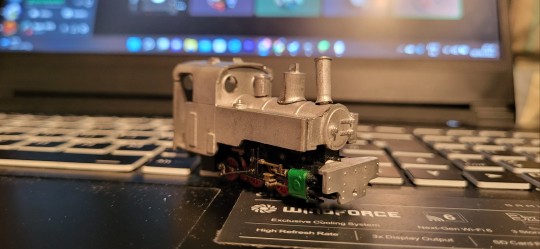
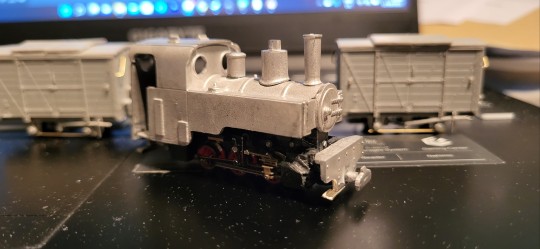

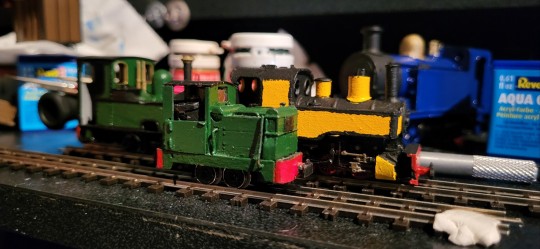
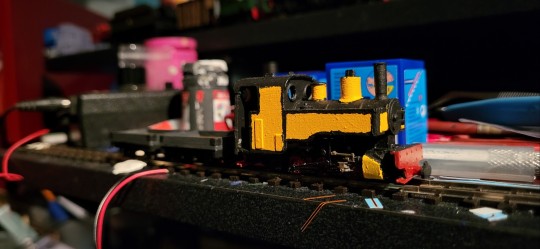
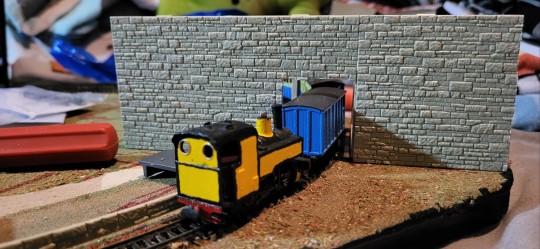
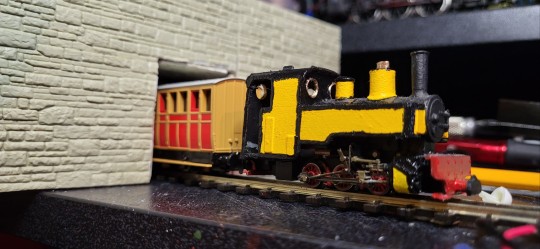

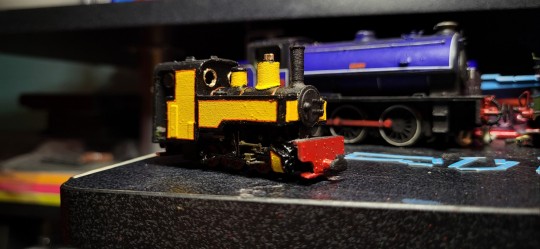
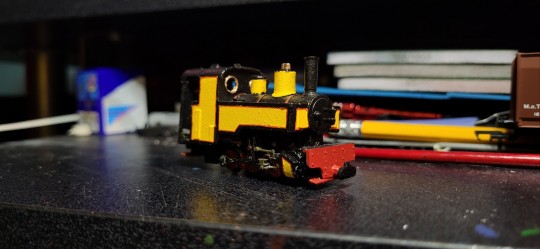
1 note
·
View note
Text
Hello there! Long time no see?
Before I talk about this model I do have to apologise for not uploading since my last post, life and mental health took over a lot and I just didn't have time nor motivation to post anything. However I'm going to try and make this a more constant thing rather than just whenever and whatever. I still need to plan out stuff, however I'll update you all when the time is right.
Anyway, today's model is of a locomotive I've taken some interest in, this is a 9F.
British Railways 9F class No.92250 was built at Crewe Works in 1958 and became the last steam locomotive to be fully constructed at Crewe. It was intended to be the last 9F built, and on top of that the last steam locomotive built by BR, and on technicality, if we're going off locomotive numbers, it is. However, 9F No.92220 'Evening Star' became the last 9F built and overall the Last Steam Locomotive built in 1960, by Swindon.
Despite the factor Swindon officially built the last 9F, I've never had a soft spot for Evening Star. However, after coming into ownership of a couple 9Fs, I was wondering what to do with them. The first one I got was a Single Chimney 9F which, as I have my own Railway Series Headcanon, will become some form of my Murdoch, and the second one, which was this one, was a Double Chimney Variant, but the loco only, with the tender it has coming from a Standard 5. The latter 9F was going to be a project by my friend Amethyst, known on Twitter as Merry Hampton Productions or @/B661Sutton (link at the end of post), to turn into a Double Chimney member of the class based around Tyseley.
Now, I had 251 9Fs I could have chose to turn this one into, however, as I work in Crewe, am quite local and also have taken interest into a majority of locomotives built there, I thought that 92250 would be the best fitting.
The first thing this model required was a new chimney. The later batches of 9Fs were all built with the Double chimney and blast pipe arrangement, however, 92250 was a little bit different.
In the 50s, Dr. Adolph Giesl-Gieslingen (what a name) designed and produced a type of chimney and blast pipe arrangement that would use steam more effectively which would help reduce the amount of coal an engine would intake. It was fitted to many engines in service and Preservation, a famous example being No.4 'Edward Thomas' on the Talyllyn Railway, and his Sudrian Counterpart Peter Sam.
92250 was built in 1958 and a year later in 1959 was fitted with an oblong Giesl Ejector. This chimney offered the same level of draught for a reduced level of back-pressure or created an increase in draught with no performance loss elsewhere. There was no change in the usage of coal either, so overall the chinmey made little difference to the 9Fs already stirling performance. 92250 retained this chinmey until withdrawal in 1965 and was Scrapped at Cashmores in Newport.
The chimney I used on my model of 92250 was a white metal one from RT Models. The chimney is designed to replace the ones on the Hornby Austerities and is more fit for industrial locomotives, so on the 9F it's a little bit short, however with little reference to how long it is, I removed the old one, cut down this one, and fitted it. It still looked the part however from some angles compared to pictures you can tell its a little too short.
After this the model was painted Black. For my black paint I use Revel Aqua colour. Their matt and gloss blacks have some good coverage, and as they are the colours I use most, I can go to my local Hobbycraft and pick them up easily.
After painting, I had to scrape most of the Factory Weathering off the Rods, add the numbers and Crests, which are all transfers from Fox Transfers (link to the numbers and crests bellow) and a nice coat of Humbrol Matt Varnish. I went for Matt as it was to hand and also as it would dull back the very glossy effect of the paint.
So that's all it was for 92250, a rather quick and simple project, which anyone could do as a good starter project.
Here is a link to Amethyst's twitter, where you can go and see her lovely modelling projects:
https://twitter.com/B661Sutton?t=tl58JqYScDFAOGbV-quvCw&s=09
And here is a link to the Transfers I used from Fox Transfers:
https://www.fox-transfers.co.uk/steam-cabside-numbering-3-sizes-58502
https://www.fox-transfers.co.uk/early-lion-and-wheel-totem-58306
Picture credit from below are to their respective owners on Flickr
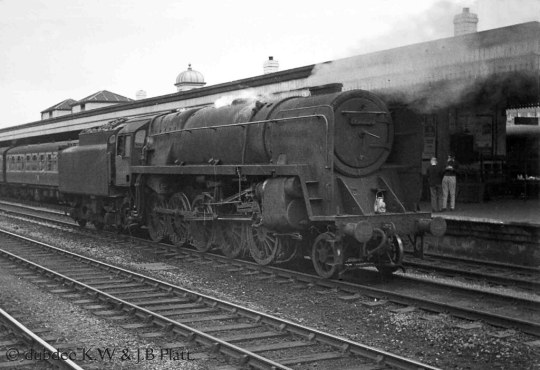

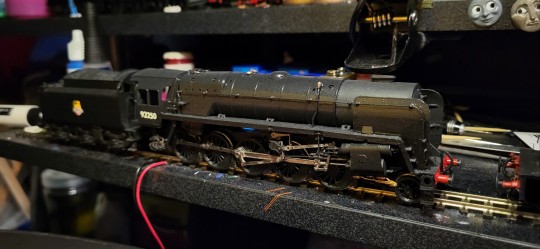
11 notes
·
View notes
Text
Been meaning to post recently, but time got it the way and also flew by.
However, a quick one today, and one of my Railway Series models, Stuart.
Background of Stuart: One of the Rev. W. Awdrys Charaters, Stuart was the Mid Sodor guise of Peter Sam, akin to Corris No.4 being the Corris era of Edward Thomas.
Originally I wanted to model the present day Peter Sam, with Giesl ejector chimney and in Skarloey Railway red. However, to do something with the Fourdees Kit that I hadn't seen done, I thought to do Stuart instead.
At the time Fourdees hadn't made the Corris Condition of the tattoo as a kit, so I took the Era 1 Condition of the Edward Thomas kit, chopped the buffers off, made a wooden bufferbeam out of a coffee stiring stick, and cut the running board off, filing at the more rough areas. After this he was painted in plain green and had his bufferbeams in Red, fittings in Brass and the rest in Black.
Stuart stayed in Plain Green and unlined, as I preferred him without the lining, however he didn't look right clean. As I model modern day Sodor, I thought to model the latest Condition of Stuart, which would be when the railway was slowly closing down the the engines wouldn't be looked after. I decided to weather him, and he now remains like this.
While his external condition says other wise, Stuart is one of the best running engines I have in 009 because of the Peter Sam chassis it sits on.
I do love my model of him, as its different and unique, and everyone using the Fourdees Corris condition kits, I can one up you and say I did it first 😊







19 notes
·
View notes
Text
I just love to stick on the model trend! But I haven't done much art recently so give it time.
Anyways, I've shown off two completed models, now I think it's only fitting that I should show off some of the many work in progress models I have.
Model making comes in leaps and bounds and has many different stages. The painting stage is a simple fun stage that I like to sit at most of the time, however it means that locos just sit in one plain colour for a long time, and that's what's happened to most of my projects. Lining out models is another stage and, for me, can be quite tedious. The amount of models I have to line out is frightening, but to have the completed model does mean more to me than having a WIP project taking up desk space! Final stages include spraying a model with a protective coat of varnish and/or weathering the model before varnishing.
Some of the models I have as current WIPs are mostly fictional and are Canon to my little model railway world.
A nice one to start with is of my GWR Collet Rebuilt City class!
In my Model World, the 30s were a weird time on the Great Western. They needed light weight passenger orientated designs for piloting duties and branch services. Charles Collett, Chief Mechanical Engineer at the time, had already come up with his Dukedogs, combining the chassis of a Bulldog with the boiler of a Duke, giving them their nickname. However, while they were ideal for the rural branch lines, they weren't best suited to piloting duties. Train piloting, more commonly known as double heading, was to help give more power to move trains. While Castles and Kings were plenty, the older designs like the Saints were finding it hard to keep up on the heavier expresses out of Paddington. Collett went back to the drawing board and brainstormed ideas. Taking inspiration from the Dukedogs, and knowing their performance on passenger trains, Collett found the perfect engines.
The GWR City Class, designed and built by Collett's predecessor, George Jackson Churchward, started their working lives in 1903, by the 30s however they were old engines of a bygone pre war time. The GWR was modifying, and there wasn't any future for them. Or so it was said.
Collett went to the withdrawal sidings at Swindon and picked out the last two members of the City class, No.3718 'City of Winchester' and No.3719 'City of Exeter', and took them into the works for modifications. The two locomotives were overhauled and received Collett style cabs.
The two were put to work on Piloting the Saints, Stars and other elderly designs out of Paddington on trains too heavy to handle. Because of their success Collett wanted to rebuild No.3716 'City of London' and No.3717 'City of Truro', unfortunately for him, No.3716's despoal dates had been finalised and No.3717 had been preserved by the London & North Eastern Railway because if its claimed 100mph run.
Later on in life, as the Castles and Kings dominated the Western Mainlines out of Paddington and the Stars were rebuilt or withdrawn, Nos.3718 and 3719 found little work. However, a notorious route was calling them. The Devon and Cornish Banks in the South West were the GWR's steepest gradients. Often trains were banked or struggled over the grades. For the larger passenger workings the two locomotives were reallocated to Newton Abbot. Express trains would stop here one of the Cities attached to the front, and the train was piloted over until the gradients were level enough. At the next station from their location, the train would stop, the City uncoupled and the Express would continue on. The City loco would then be turned and pilot another express in the opposite direction.
When reallocated, No.3718 'City of Winchester' was renumbered to No.3518 and No.3719 'City of Exeter' became No.3519. This was done so that new 5700/8750 Pannier Tanks could take their numbers in the 37xx range.
The two locomotives carried these number until their withdrawals in the 50s. They out lived all of their class, except for 3717 'City of Truro', and gained an extra twenty years on their life. They bowed out of service like proper ladies, piloting two trains over the Devon and Cornish Banks, before double heading a train to Swindon Works, their final resting place.
My WIP model of the Collett Rebuilt City Class is the Airfix City of Truro kit, which is still available by Dapol. Because of how 00 gauge can be sometimes double heading locos, this loco is a freewheeling Dummy loco, however if I could, a tender drive modification could be made so she works under her own power. My plan is to make this one No.3518 'City of Winchester' and put her in the condition she was in during her time on the Devon and Cornwall banks.
This loco was a reignited project from a long time ago, so not many pictures of her model being built are on my current phone, however I do have this photo of her in her current wip condition. She is ready for name and number plates, however due to money and also the factor that the plates need to be custom etched, Winfred, as she's been nicknamed, will be in this condition for some time. However when she gets her plates, a future update will be made.

1 note
·
View note
Text
Hi all! I'm here to show off another model!
This one was a little passion project that didn't really start until I realised I needed to complete a group of locomotives.
The London & North Eastern Railway's class A4s were the East Coasts most premier express locomotives. There are many models of this locomotive available across many gauges. In N gauge there is the old Minitrix model and the newer Dapol ones. In O gauge there are kits or the new ready to run Hattons model, in partnership with Heljan. And in OO gauge there is the older Bachmann model, the constant re-releasing Hornby Super Detail models and the Hornby Railroad model.
For what it is, the Hornby Railroad model is very good in quality. While the plastic moulding and the finish of the model makes it look very matt and bland, with the cheaper printed details not helping its case, the model is very well detailed, even with its moulded handrails and lack of features like lamp irons. Surprisingly, the model has brass fittings. Both the chime whistle in front the chimney and the safety valves embedded in the cab roof are turned brass, and stand out against the matt finish.
The reasoning behind wanted an A4 is because, within being on an Eastern Region kick, I have a Peppercorn A1 and A2, an A3 and to complete the group I wanted an A4. Luckily a mate of mine was selling a job lot to Rails of Sheffield with a Railroad Mallard and spare A4 body included. I offered a better price for it all, and that same day I got the models. My mate had previously modified the locomotive to have the Super Detail A4 valve gear, which did make the model look better. However, the A4 wasn't going to stay in "as purchased" condition for much longer.
Not long after I got home, after buying the models, I grabbed the spare body and attempted my plan of action. I cut the valances off of the spare body, using the inside of the bodyshell as a guide of where to cut, I scored a couple times down the valances before bending them out, making it easier to remove as the plastic on the Railroad models is softer than most models.
Because the cutting of the spare body worked out so well, I decided that I'd swap the bodies over and use the spare one on the final model. However one issue I faced with the spare body was the lack of chimney. Now that the original body was now spare, I removed the chimney off that body to put onto the spare one.
Other things that were changed to the body was the removal of the moulded handrails, addition of new ones using short handrail knobs and 0.45mm brass wire, and fixing any small mistakes on the valances with a file.
While I was detailing up the body the thought of "which A4 do I model" was crossing my mind. A lot of my Eastern Fleet worked all over the LNER. My A2, No.60538 'Velocity' has many pictures and videos of it working around York and Newcastle. The A3 I own is of No.60103 'Flying Scotsman' which worked all over the network in its lifetime. A lot of the smaller Eastern engines I own worked around Scotland or the South East. So when picking an A4 to model, it would be a preference to a name and which one was in similar condition to Mallard. In the end this was thrown out of the window.
Time for a little bit of Fake History!
The London and North Eastern Railway A4 locomotives are one of the most famous British Pacifics built. Its distinctive Streamlined casing of the 1930s giving a look of style and speed.
The original four A4s were nicknamed the silver batch because the names contained the word silver. Later batches would be named after birds but would later be renamed after famous and distinctive people. Originally the A4s were only going to have 35 members, however upon request from Kings Cross, a 36th member of the class was built on the 5th August 1938 and went around nameless until a name was decided.
4904 (the J39 doesn't exist) was sent to King's Cross as the last member of the A4s, fitted with a double chimney, as standard of the later batches, painted in LNER Garter Blue. The men at Kings Cross were allowed to choose the name, and after a number of months at Top Shed, it was requested for its name to be Thunder, a striking name for the last member of the class.
However the nameplates would never be fitted. In 1939, a year after the locomotive's construction, the Second World War broke out, and like other members of the class, 4904 was painted in a plain matt black, but didn't receive the NE lettering showing its home routes and allocations. Because of this, the locomotive was nicknamed "the Black Shadow" or "Eastern Ghost". 4904 roamed the network and managed to go to places such as Crewe, Birmingham and even Exeter during the war, making the engine become some sort of urban legend. The legend was enhanced when LNER 4469 'Sir Ralph Wedgewood', previously known as 'Gadwall', was blown up at York Sheds on the 28th April 1942. What started out as a nickname, 'Eastern Ghost' became a myth. Many workers mistook 4904 as 4469's ghost, while it went about its work at night.
When the war ended on the 2nd September 1945, 4904 was in a sorry condition. Two months previous the locomotive's axle boxes ran hot and were in desperate need of replacement, alongside this, the conjugated valve gear, which was built to be regularly maintained, was becoming worn due to a lack of maintenance. 4904 was the first A4 to be overhauled post war because of these factors. The axle boxes were striped and scrapped, new ones were casted and refitted. Parts of the valve gear that were salvageable from 4469 were used, but most of the rods were recast from new.
Finally on the 24th December 1945, 4904 emerged from Doncaster works. It was renumbered to No.35 and Finally received its nameplates, painted in a striking red. There were debates for the engine to take 4469's name of 'Sir Ralph Wedgewood' but another A4 was given the name (No.4466, later No.6, and later again to No.60006).
The locomotive throughout the rest of its life was Numbered 60035 and bounced about the East Coast performing duties on many of the named trains around the areas he was based at.
Having a majority of the locomitive's fake history written up, and out of boredom at the time, Thunder was painted I'm Wartime Black with the numbers painted on by hand with a toothpick in white. After this I realised I kinda copied the Sir Nigel Gresley 60007 trusts idea due to SNG currently wearing Wartime Black.
Thunder stayed in this condition for some time, I didn't have the nameplates or paint, so he sat in Black until they were ordered and arrived. Not long after arrival of the paints and plates, the locomotive was painted, lined, numbered and crested and was finally bestowed its name. Very fitting as it loosely followed his fake history.
Thunder, like Ryan, is a jewel in my fleet, sleek, shiny and unique. This project took me just over a month to do, and proves that, with minor modifications, that the Railroad Models can be bought cheap and made to look as good as the Super Detail Models available for double to price.
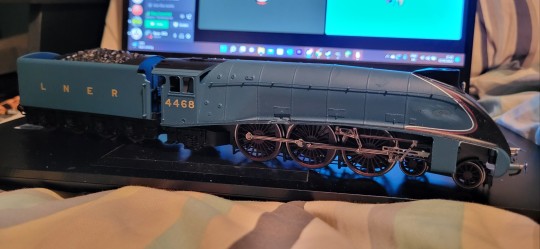
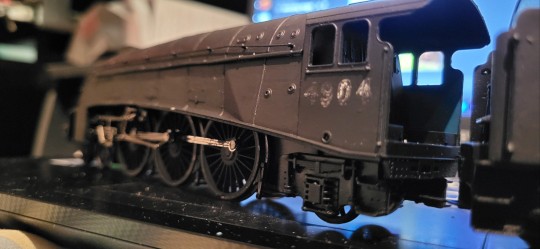
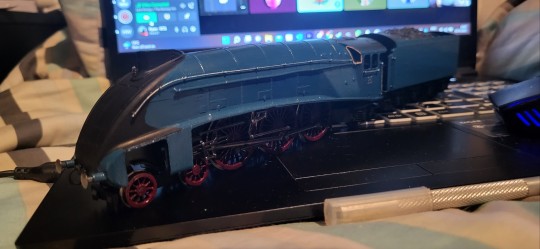

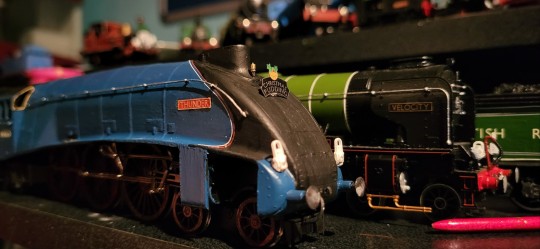
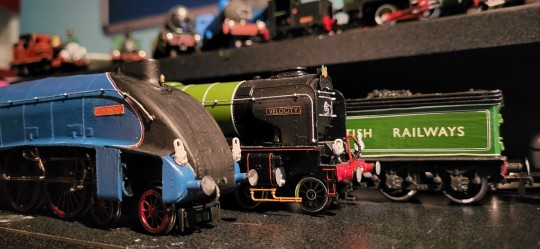
13 notes
·
View notes
Text
HELLO ALL!
I thought as a good way to start my Tumblr page was to talk about one of my favourite models, which has recently got an Overhaul.
This Austerity, named after myself as an Original Character, was originally a Hornby Lord Phil model. Bought back in 2018, the model was one of the first models I got when going back into 00 gauge modelling.
Originally, his paintwork was a light blue, at the time I used Enamal blue, however having found my preference in Acrylic paints, I'm so glad that he got a repaint not even a year later.
Ryan received the Dark Blue seen in the first few pictures in late 2018. At the time I wanted a specific colour, so the paint he's worn most of his model life is actually Baker's Street Blue. The original Enamal light blue was sanded back and painted over. He was then lined out in Fox Transfers BR Blue Lining.
However, in October (2022) I thought about redoing him entirely. Because of the nail varnish paint, I carefully stripped him back to plastic. Many details were removed and I converted him to left hand drive as the base Austerity models are all right hand drive.
On Ryan's current model has the followinf things; he's a basic Hornby Austerity, with replacement short handrail knobs and 0.45mm wire; RT models Austerity parts such as new chimney, tank filler caps, dome, cab detailings and new buffer beams; buffers are 22" oleo buffers; new smokebox door; air pump from a Dolgochification kit; couplings from Silver Tay Models on Ebay; and any other detailing parts are bits I had in Spares boxes. Paints used are mixes of Revel Aqua Colour Acrylics, Matt and Gloss Black's and Ultramarine Blue, while the buffer beams are in Humbrol 19 Gloss Red. Lining is 0.35mm while lining with nameplates from Narrow Planet.
Finally he was weathered down with humbrol black soot weathering powder. Only lightly, but it was done in places where dirt and soot would cover him, like across the top of his tank and in areas around his cab.
Ryan is a crowning gem in my fleet, a locomotive I'm proud to own. A highlight of him in his new condition is that at Warley 2022 I was allowed to have him run on Awdry's own Ffarquhar Layout. It's a funny little rounding off, a locomotive created as a character for me inspired by Awdry's characters. It was a happy honor and I thank the Ffarquhar Rats for putting him on.










6 notes
·
View notes
Text
Hello Tumblr!
Hello Everyone, I'm Ryan, also known as Ryan T Shaw - RTS on Twitter.
In the worrying case of Twitter shitting itself, I thought I should create a Tumblr page to continue to share my interests.
I'll post stuff soon but please consider following for model railways and artwork!
1 note
·
View note
